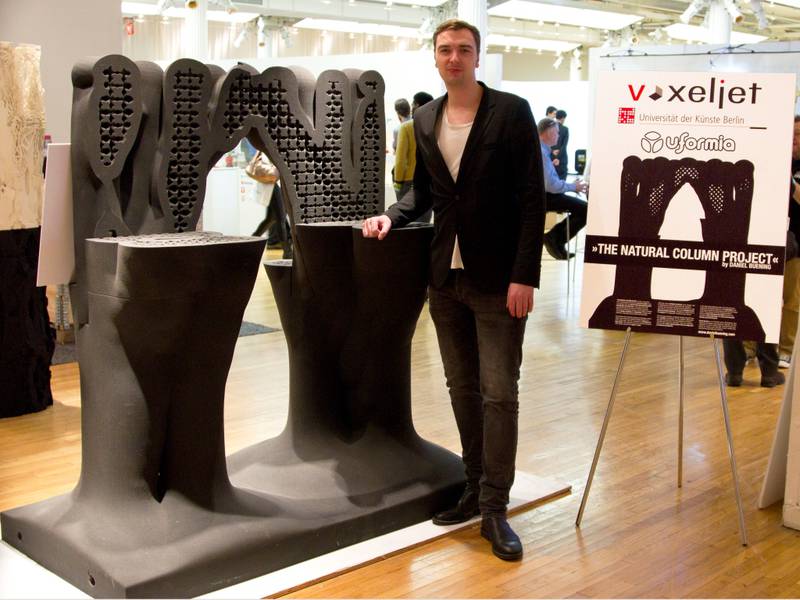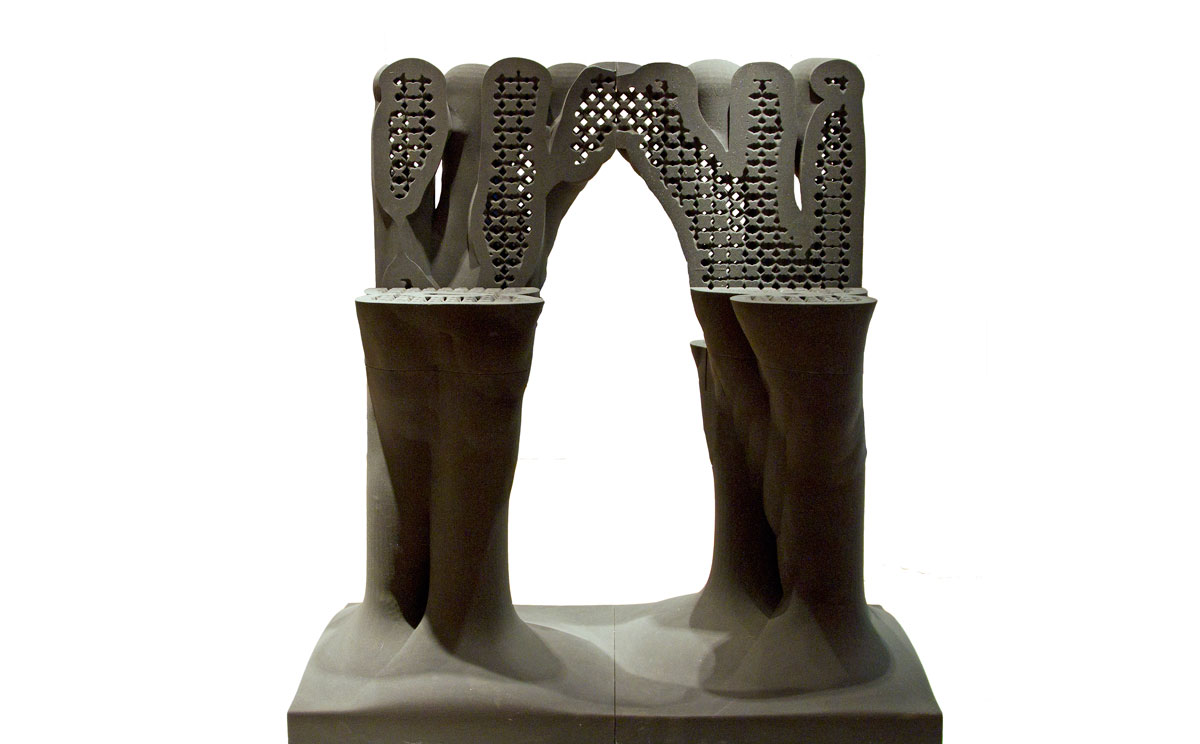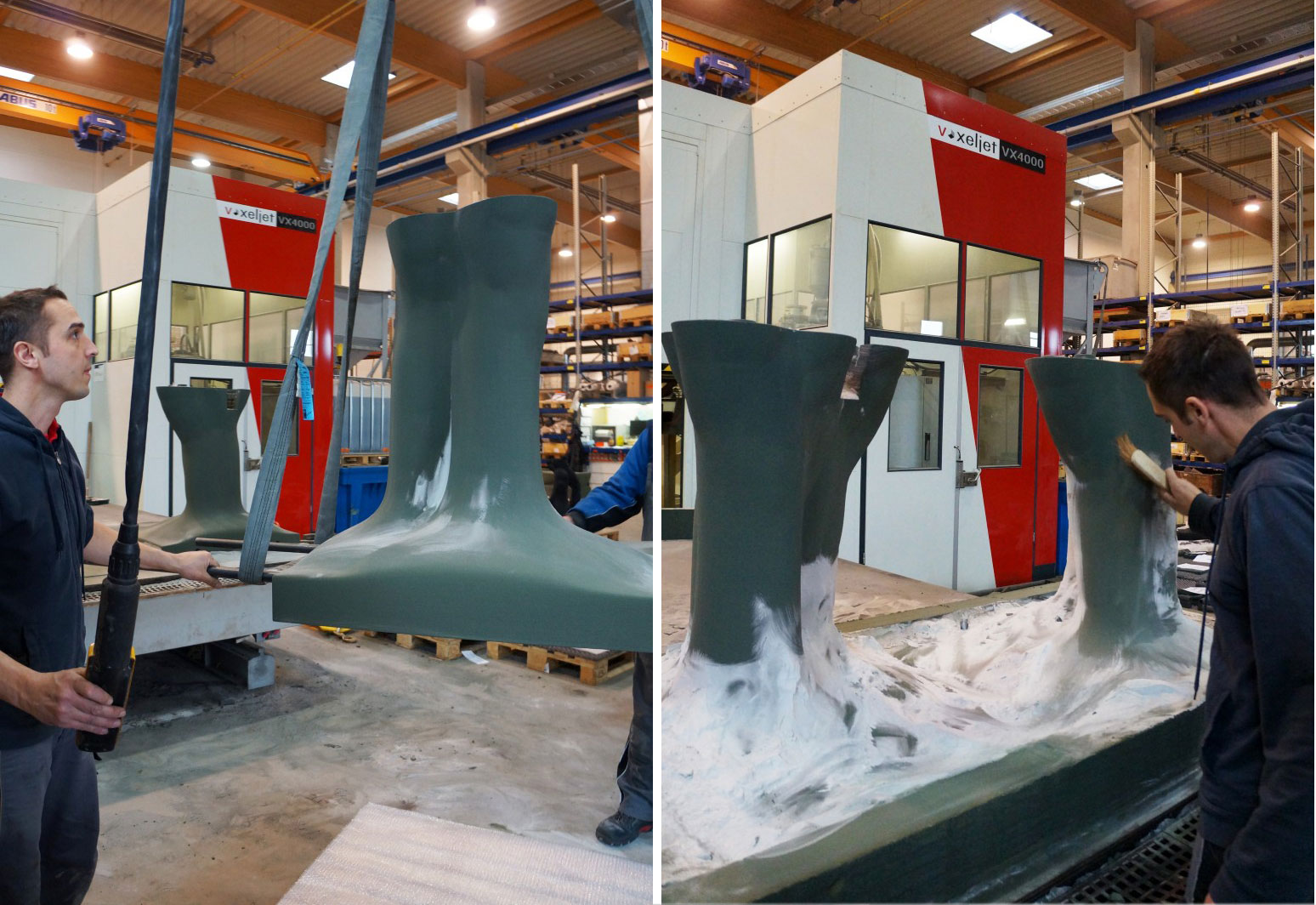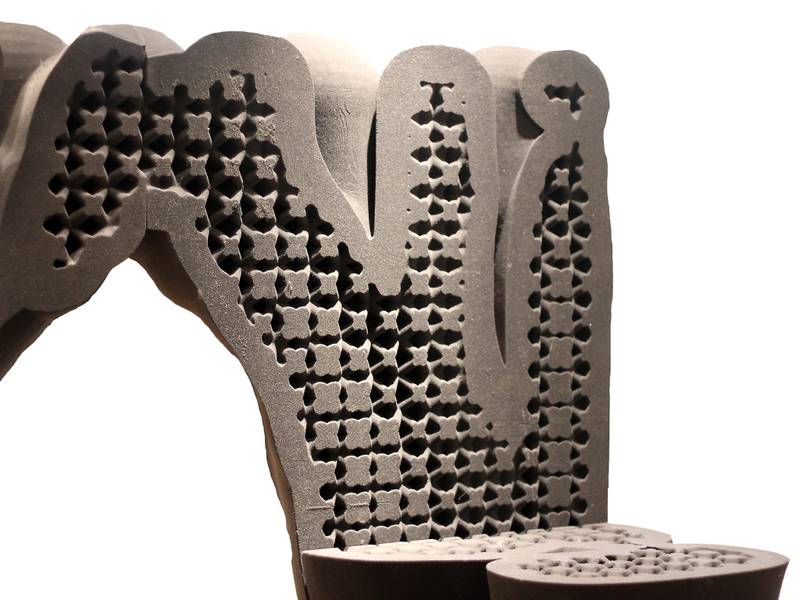Daniel Büning is an Architect and a Researcher who combines emerging computational methods, with the utilization of novel cutting edge manufacturing technology to create digitally informed architectural objects. He is a Research Assistant at the Technical University of Braunschweig, IMD Institute for Media and Design of Prof. Matthias Karch. Since 2012, he has been a Ph.D. Fellow and Lecturer at the University of the Arts Berlin, DEE Department for Digital and Experimental Design of Prof. Dr. Norbert Palz. Daniel received a Masters Degree in Architecture (with Distinction) from MSA Muenster School of Architecture, and spent a year in the M-Arch Program at PRATT Institute in Brooklyn, NY.
His work was distinguished with many grants inter alia: Fulbright Comission, German National Academic Foundation, MEXT Ministry of Education Japan and Friedrich-Ebert Foundation.
He was awarded with the Bauwelt Scholarship for his Master Thesis in 2011.
Andrew Wheeler is a Technology Officer at 3DP4E.com, who is doing a special interview series with key figures in the world of 3D Printing and Digital Fabrication. He first met Daniel on February 12, 2014 at the 3D Print Show in NYC. Daniel was displaying his Natural Column Project, which is an amazing architectural structure designed by Daniel and 3D printed by Voxeljet. He caught up with Daniel again more recently:
Andrew Wheeler on behalf of 3D Printing Industry [AW]: So what have you been up to?
Daniel Buning [DB]: Oh, crazy times.
AW: Crazy times around the world?
DB: The natural column project is just back from NYC, because they had problems with the shipping logistics.
AW: What happened, did they drop it in the water?
DB: They messed up in New York harbour, and it took three months to get it back. Some of the labelling was removed, and therefore the logistic firm could not reference it anymore and also not define its final destination.
AW: So it was in storage, it wasn’t on display.
DB: Correct. Luckily I had no direct plans with it after the 3DPS NYC.
AW: I remember the basics behind the natural column project. You were trying to find the right internal geometry to maximize the load bearing capacity of your column. Can you tell us a little bit about that.
DB: I´ve been investigating construction scale 3D printing since 2011. Is it possible to apply additive manufacturing technologies to current methods of construction? And how can we enhance construction sequences through 3D printing in combination with various digital simulation processes? The column and some of my other projects are looking into, lets say, an envelope of a geometry, which is optimized through a structural simulation sequence and in a consecutive step an inner microstructure is created, which further optimizes the overall performance of the object. This means that in an iterative computational process material is taken away in areas of the object, where it is structurally not needed, and at the same time this procedure saves weight and material, which is what makes it interesting from a sustainability perspective. Therefore, the resulting objects are characterized by a high structural performance to material saving ratio. This is similar to natural structural systems. Nature is super-optimized, in a way that it will only use as much material as is needed to create a structurally valid and performative system. That’s actually my approach to a proper use of 3D printing technology. By using the real capacities of those digital process chains, one will be able to unfold a totally new and unseen typology of digitally predefined objects that would be impossible to create with another fabrication method. I therefore believe that we should start to use additive manufacturing by triggering its real potentials (for the creation of complex internal structures within an object) and enhance industrial sequences and design processes to create more digitally informed, sophisticated and cost efficient products. This seems to be a better option than using it to print out profane objects using established manufacturing processes.
AW: What do you think is the biggest obstacle for 3D printing to break into mainstream construction?
DB: From an architect’s point of view, the problem is that the column is made out of sand. Voxeljet invented their technology/process for casting. I am talking to a lot of firms and scientific institutions, like DTU Copenhagen and other companies such as EADS Apworks in the aeronautics industry. From an algorithmic and from a digital process side, they have similar problems. They are already able to have optimized hull geometries, like the outer shape of the natural column. But to have a coupled simulation process, which optimizes the exterior and the interior at one time… that’s something that nobody is currently able to do. It means that the algorithm would have to check back and forth to see where structure is needed on the inside, and where material can be removed on the outside. And this sort of feedback loop is really difficult to do from a mechanical engineering and a computational point of view. Recently I talked to a lot of mechanical engineers, because this is a mechanical and mathematical problem, but they just started to investigate this problem. But I’m sure that there will be some interesting results in the near future.
AW: How do you go about synthesizing the evolved optimized load bearing capacity found in the internal geometry of nature?
DB: It’s really interesting. For example, if you look inside a bone (on my site), you have the exterior hull shape and an internal hull microstructure, which are on the same scalar level, which is apparent to the naked eye. If one looks a little closer (at the nanoscale) blood vessels and channels for the transportation of nutrients are visible. From an additive manufacturing perspective it is interesting to think about how to replicate the formation of a structure such as this. What I do is think about how we can somehow digitally calibrate all kinds of objects to develop an enhanced and informed structural configuration. Imagine you have a column that is freeform and looks organic, but it has an embedded logic of structural performance cavities for media flow such as water or electric wiring. If further research goes into the invention of a multi-material printer, that could fill different cavities with different materials, such as conductive materials that would be simultaneously “woven” into the structure itself for electrical usage, one could build stronger optimized structures with wiring and plumbing possibly already built in.
This could be seen as a new class a prefabricated architectural elements, in which functional criteria such as media flow are fully embedded into a structural element e.g a column or wall.
AW: You must have to take so many things into consideration when exploring this technique. The way that a natural structure reacts to different chance obstacles and elements in its environment must be very difficult to simulate.
DB: This is what we call a multiple optimization problem, from a mathematical and algorithmic point of view. These Evolutionary Algorithms (EA) have been around since the 50s, but their practical implementation started with the emerging possibilities of high-performance computing technology. Nowadays they are used in the medical field, where they are used in many ways, such as bone tissue growth algorithms. The natural column was one of the largest 3D printed structures that has been manufactured so far. From a free-form design perspective, it has such complex undercuts, that one cannot mill it or cast it. It has an incredibly high printing-resolution and the microstructure is created in accordance with the internal force flow. This means that the contained internal structure gradually changes its thickness diameter/radii in respect to the locally detected stress values. But honestly this is just a first small step in comparison to natural systems and their embedded complexity. In nature, it wouldn’t be just a variance in thickness, where no structure is needed, no structure is grown, it would also be a non-periodic structural configuration. Compare that with my structure, which is periodic and stacked, due to the limits of structural analyzer software, and works in 3 dimensional quad cells.
AW: Are the cells a certain shape?
DB: I designed an X shape cell, due to its structural capacities, to implement into the so called “topology optimization (TO)” process. You have to imagine this structural simulation process as follows: One has to design a box that consists of finite element quad cells, and one has to define a load case and support conditions. In an iterative process, the software will “kill” those cells that are not needed in order to maintain structural validity. Normally these stacked cubes are smoothed with a mesh algorithm, and you get organic shapes. What I’ve done on top of this is I’ve created a feedback loop inside this algorithmic box, so that the numeric values contained in each structural cell for local stiffness, density and deflection are extracted and fed back into the process, to control the radii and material usage of the internal substructure. Therefore the change in size and structure happens automatically and reactively.

DB: Honestly, from a material point of view in this case, there was no real option. Voxeljet has only one material. In the beginning, I was considering working with Enrico Dini from D-Shape. He is using dolomitic sandstone for full scale printing in Italy, which I find to be very interesting. He is basically using the powder of this material, which was previously used to build churches in the renaissance. Using additive manufacturing, he built a structure that has the weight and the texture of the sandstone. From a thinking perspective, you have a sandstone block, then you translate it into powder and in the end you turn it into a different object via a 3D printing process (laughs). Sort of a reverse engineering process. After I talked to Enrico, I started to contact Voxeljet about their material options. Normally, I would be comparing the properties of different materials in terms of stiffness, coarseness and a few others before beginning to design a solution. In this case the column is made out of the same sand Voxeljet uses to create large-scale mouldings for metal casting.
Don’t get me wrong, Voxeljet is a fantastic and innovative machine building company, and I believe that they will be able to come up with great material solutions, such as concrete, which may be suitable for 3D printed construction.
AW: Have you worked with any other companies besides Voxeljet?

We worked together on a cellular solid object, which is basically a foam block that is characterized by a gradual three-dimensional porosity. For the materialization we used their patented metal alloy “Silmagal” which is a aluminium/magnesium alloy (AlSi7Mg). The structure has a continuous wall thickness of 0.15mm and as a result is simultaneously super lightweight and very rigid. It is very important for me to work with professionals from all kind of scientific disciplines to get advice and learn from them. This an absolute necessity due to the fact that I have an architectural background and I´m not a mechanical engineer or a material scientist.
I’m also working very closely with a company called Uformia. Without their software, a lot of my projects would not be possible. They invented this new software called Symvol, which overcomes meshes and nurbs in the 3D modelling environment and establishes a new volumetric method in which everything one creates is always “watertight” and ready for 3D printing.
In my work I’m also very interested in geometrical models and new innovations in the field of computer graphics. The difference between established programs such as Maya and Symvol is: if you want to combine two shapes, these two objects have to be of the same topology (meaning they have to contain the exact same amount of vertex points, edges and faces) in order to perform a shape transformation between the two. With Symvol, you can morph multiple objects that are not of the same topology in a continuous manner.
The applications for this type of process are immense. Imagine you have a cell structure of a certain topology and one of a totally different geometrical articulation in different parts of a structural element. Both could have different geometrical shapes and perform differently in accordance with the local structural requirements in different areas of an element. But with the use of Symvol it is possible to continuously morph smoothly from one shape to another three-dimensionally. But the main reason I was so interested in this software was due to the potential of combining multiple different cell structure types as well as transitioning a structure into a combination of them when it is necessary. For me this was mind blowing when I was first used it, because it allows for a radical new way of using shape transformation to create previously impossible objects.
AW: Do you use scanners at all in your design process?
DB: Scanning is really interesting, but what I am more interested in is examining image stacks using slice data. A CT scan, which is a pretty old technology, scans in every layer of your body, and into .1 mm slices. In this data, there is a discrete description between borders of different body parts. There is a segregation software technology that is used to build a 3D model of a particular body part based on these discrete borders that are defined by the slicing data. This allows for the creation of heterogeneous 3D models such as the human brain, which is characterized by a complex interwoven geometry.
The resulting 3D model is then sent to the printer as an STL, file, which is then cut into slices again in order to print it in a layer by layer process. Instead of sending an STL, it is also possible to send the slice data directly to the printer. This is what’s known as direct fabrication.
In all of these projects I’ve done so far, there’s always a relatively discrete border between the outer structure and the inner structure, or between the inner structure and the cavities, but imagine you have these gradual transitions, these blurs of different topologies according to specific design needs. I think it’s something worth investigating
AW: What was the Micro in Micro project about?
DB: If you click on this on my site, you will see how there is a microstructure embedded in another microstructure. This directly addresses and investigates our current limitations in terms of constructing internal geometry at smaller and smaller scales. Due to the thousands of intersections caused by the microstructures, this recently became possible with Uformia’s volumetric modelling technology. This was especially helpful in creating a watertight geometry, which is necessary for additive manufacturing purposes.
AW: In the future, do you think it will be possible for a printing process to include an apparatus that will allow it to react to its environment the way a tree does throughout it’s growth cycles?
DB: I know that in bioprinting, they have a casting process where they create a superfine structure, and then inject living cell biomaterial into it, which grows on the casting. Later the casting is later removed or dissolved, and you are left with a living structure.






